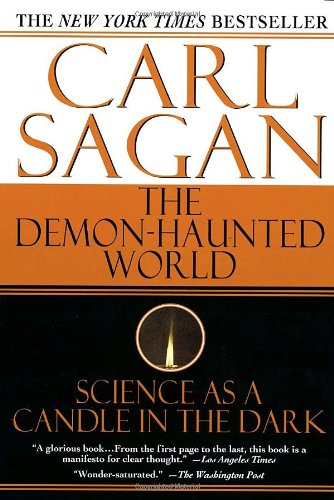
Carl Sagan endures as our era's greatest patron saint of reason and common sense – a true master of the vital balance between skepticism and openness. In The Demon-Haunted World: Science as a Candle in the Dark (public library) – the same indispensable volume that gave us Sagan's timeless meditation on science and spirituality, published mere months before his death in 1996 – Sagan shares his secret to upholding the rites of reason, even in the face of society's most shameless untruths and outrageous propaganda.
In a chapter titled "The Fine Art of Baloney Detection," he reflects on the many types of deception to which we're susceptible – from psychics to religious zealotry to paid product endorsements by scientists, which he held in especially low regard, noting that they "betray contempt for the intelligence of their customers" and "introduce an insidious corruption of popular attitudes about scientific objectivity." But rather than preaching from the ivory tower of self-righteousness, Sagan approaches the subject from the most vulnerable of places – having just lost both of his parents, he reflects on the all too human allure of promises of supernatural reunions in the afterlife, reminding us that falling for such fictions doesn't make us stupid or bad people, but simply means that we need to equip ourselves with the right tools against them.
Through their training, scientists are equipped with what Sagan calls a "baloney detection kit" – a set of cognitive tools and techniques that fortify the mind against penetration by falsehoods:
The kit is brought out as a matter of course whenever new ideas are offered for consideration. If the new idea survives examination by the tools in our kit, we grant it warm, although tentative, acceptance. If you're so inclined, if you don't want to buy baloney even when it's reassuring to do so, there are precautions that can be taken; there's a tried-and-true, consumer-tested method.
But the kit, Sagan argues, isn't merely a tool of science – rather, it contains invaluable tools of healthy skepticism that apply just as aptly, and just as necessarily, to everyday life. By adopting the kit, we can all shield ourselves against clueless guile and deliberate manipulation. Sagan shares nine of these tools:
- Wherever possible there must be independent confirmation of the "facts."
- Encourage substantive debate on the evidence by knowledgeable proponents of all points of view.
- Arguments from authority carry little weight – "authorities" have made mistakes in the past. They will do so again in the future. Perhaps a better way to say it is that in science there are no authorities; at most, there are experts.
- Spin more than one hypothesis. If there's something to be explained, think of all the different ways in which it could be explained. Then think of tests by which you might systematically disprove each of the alternatives. What survives, the hypothesis that resists disproof in this Darwinian selection among "multiple working hypotheses," has a much better chance of being the right answer than if you had simply run with the first idea that caught your fancy.
- Try not to get overly attached to a hypothesis just because it's yours. It's only a way station in the pursuit of knowledge. Ask yourself why you like the idea. Compare it fairly with the alternatives. See if you can find reasons for rejecting it. If you don't, others will.
- Quantify. If whatever it is you're explaining has some measure, some numerical quantity attached to it, you'll be much better able to discriminate among competing hypotheses. What is vague and qualitative is open to many explanations. Of course there are truths to be sought in the many qualitative issues we are obliged to confront, but finding them is more challenging.
- If there's a chain of argument, every link in the chain must work (including the premise) – not just most of them.
- Occam's Razor. This convenient rule-of-thumb urges us when faced with two hypotheses that explain the data equally well to choose the simpler.
- Always ask whether the hypothesis can be, at least in principle, falsified. Propositions that are untestable, unfalsifiable are not worth much. Consider the grand idea that our Universe and everything in it is just an elementary particle – an electron, say – in a much bigger Cosmos. But if we can never acquire information from outside our Universe, is not the idea incapable of disproof? You must be able to check assertions out. Inveterate skeptics must be given the chance to follow your reasoning, to duplicate your experiments and see if they get the same result.
Read more, including Sagan's list of the twenty most common pitfalls of common sense and how to counter them, here.
No comments:
Post a Comment